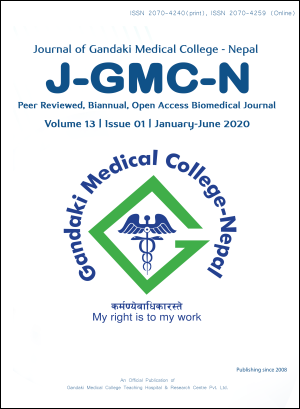Bacteriological profile and antimicrobial susceptibility patterns of wound infections among adult patients attending Gandaki Medical College Teaching Hospital, Nepal
DOI:
https://doi.org/10.3126/jgmcn.v13i1.28973Keywords:
Antimicrobial Resistance, Bacterial Pathogens, Multi Drug Resistance, Wound InfectionAbstract
Introduction: Wound infections are significant group of infections in the hospitals worldwide. The wide spread uses of antimicrobial agents lead to emergence of resistant pathogens contributing to increased morbidity and mortality. Accurate and prompt antimicrobial therapy is required to reduce the complications. This study was aimed to investigate pyogenic bacterial pathogens and their susceptibility patterns.
Methods: A cross sectional study was carried out at Gandaki Medical College Teaching Hospital from July to December 2018. Wound specimens obtained from adult patients were inoculated onto appropriate media and pathogens were identified using standard microbiological methods. Antimicrobial susceptibility patterns were determined by Kirby-Bauer disc diffusion method following the guidelines of Clinical and Laboratory Standard Institute (CLSI).
Results: A total of 264 specimens were included in the study of which 167 (63.3%) were positive for bacterial growth. Of these, polymicrobial growth was observed in two specimens. Gram positive bacteria (119, 70.4%) were the leading cause of infections, Staphylococcus aureus (102, 85.7%) being the most dominant. Among the Gram negative pathogens (50, 29.6%), Escherichia coli (31,62%) was found to be the predominant followed by Pseudomonas aeurogenosa (10, 20%). Overall, the isolates were resistance to Ampicillin (90.7%), Amoxycillin (64.9%), Cloxacillin (68%), Ofloxacin (61.5%) and Cotrimoxazole (55.6%). Lesser rates of resistance were observed to Doxycycline, Erythromycin, Amikacin, Gentamicin and Imipenem.
Conclusion: This study revealed the most common pathogens causing pyogenic wound infections in our setting. Again, these pathogens are resistance to commonly used antibiotics. Therefore, this study could be helpful to develop proper guidelines of antibiotics to be used for prophylactic and empiric treatment.
Downloads
323
357
Downloads
Published
How to Cite
Issue
Section
License
This license allows reusers to distribute, remix, adapt, and build upon the material in any medium or format for noncommercial purposes only, and only so long as attribution is given to the creator.




